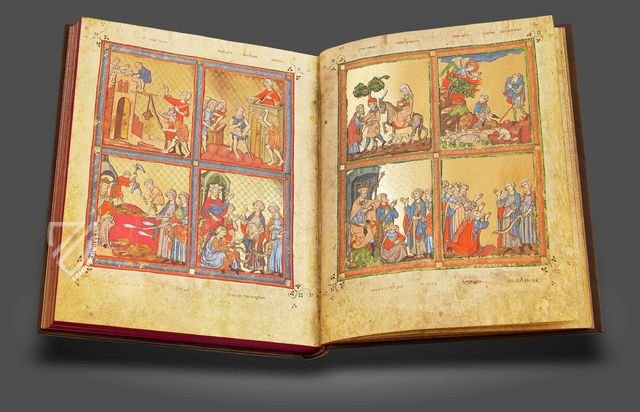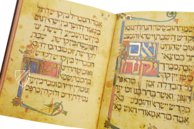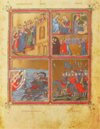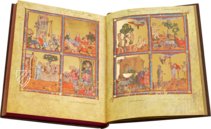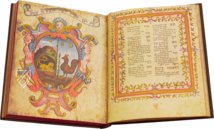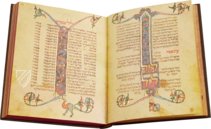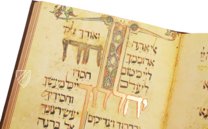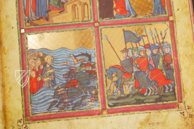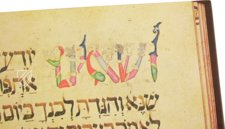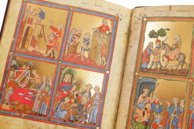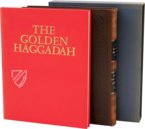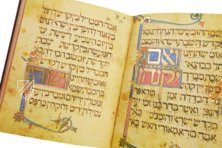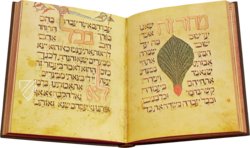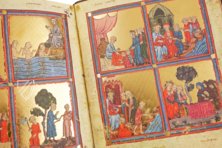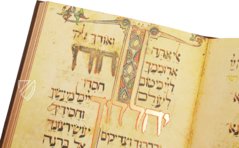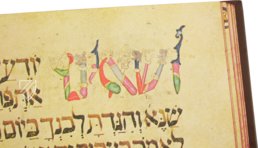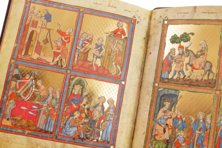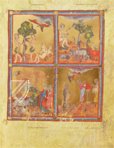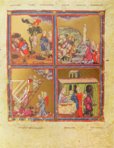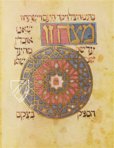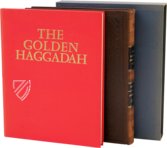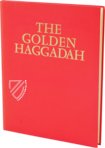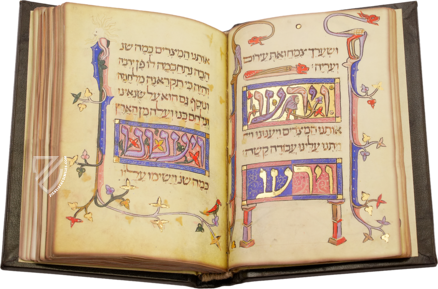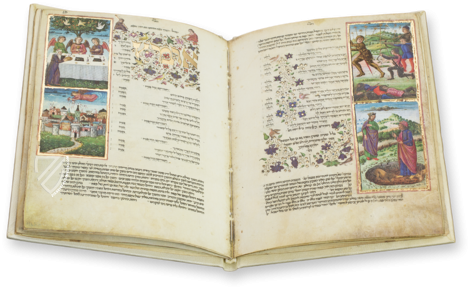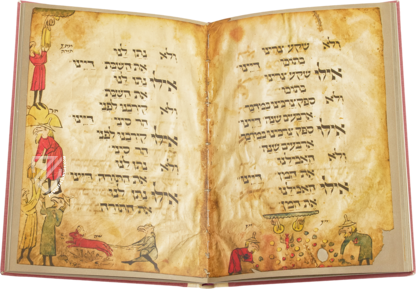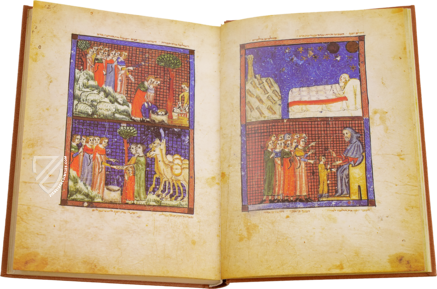Golden Haggadah
(3,000€ - 7,000€)
The Haggadah is the book used in Jewish households during the Seder feast on Passover Eve to celebrate the Israelites' deliverance from Egyptian enslavement as described in the Book of Exodus. This particular manuscript, the so-called Golden Haggadah, was copied and illuminated ca. 1320-30 in Catalonia, north east Spain. The manuscript takes its name from the 56 miniature paintings at the beginning of the book that depict scenes from the story of Passover as well as depicting the Seder itself, set against gold leaf backgrounds that have been imprinted with patterns and the Hebrew text was written on vellum pages in a square Sephardi script.
Golden Haggadah
The Golden Haggadah is a Sephardic Hebrew manuscript originating from the region of Catalonia ca. 1320-30, which was then appended with additional folios during the 17th century that are adorned in the style of the Italian Renaissance. Its name derives from its gorgeous gold leaf backgrounds with imprinted diamond patterns that adorn the 56 magnificent miniatures illustrating events from the books of Genesis and Exodus in addition to depicting the Seder as it was practiced in medieval Spain. The text consists of a copy of the liturgy used during the Seder service of Passover that guides participants through the ritualized meals. This manuscript is the earliest example of an illustrated Spanish Haggadah containing a complete image cycle from Genesis and Exodus, in addition to being a splendid work of art in its own right.
The Golden Miniatures
Although the style of the art is distinctly Gothic, elements of Romanesque and Islamic art can also be found, a nod to the multicultural nature of Spanish society in the 14th century. Nonetheless, the artists appear to have been inspired by such splendid manuscripts are the Morgan Crusader Bible and Psalter of St. Louis. Each page has four miniatures, which should be viewed in a particular order starting with the top right picture, followed by the top left image, then the lower right image, and lastly, the lower left miniature. Blue frames with arabesque patterns surround the miniatures. Nearly three centuries after the manuscript was first created, it travelled to Italy where an additional 15 folios were added in the early 17th century, which includes additional illustrations in the style of the Italian Renaissance. The first section of the manuscript depicts events ranging from Adam naming the animals to the song of Miriam. Second, the steps taken during the preparations for celebrating Passover are illustrated, including a depiction of a dragon drinking wine in addition to other important objects like the matzah and bitter herbs. Finally, a selection of 100 Passover piyyutim liturgical poems is presented with decorative initial panels.
A Mysterious Masterpiece
Neither the identity of the scribes and illuminators nor that of the original owner are known and the first few centuries of the manuscript’s existence are a mystery aside from the fact that researchers have been able to deduce that work originated in Catalonia ca. 1320-30. There is also evidence that it is the work of two hands: one artist using standardized faces but working in a graceful manner with a balanced color palette, and a second artist distinguished by a more coarse but energetic style. 101 leaves of fine vellum were used to create the manuscript, indicating a wealthy and discerning patron. The manuscript was likely taken to Italy in 1492 when the Spanish Jewry was faced with the choice of conversion or banishment. The earliest record of ownership comes in a note dated to 1602 indicating that it was given as a wedding present to the daughter of Rabbi Joav Gallico of Asti, including a page with the Gallico coat of arms. The Golden Haggadah eventually found its way into the possession of Joseph Almanzi (1801-60), an Italian Jewish bibliophile and poet, and was acquired in 1865 along with the rest of his collection by the British Library, where it remains today.
Codicology
- Alternative Titles
- Goldene Haggadah
The Golden Haggadah
Seder Haggadah Shel Pesach - Size / Format
- 202 pages / 24.7 × 19.5 cm
- Origin
- Spain
- Date
- Second quarter of the 14th century
- Epochs
- Language
- Script
- Sephardi square script
- Illustrations
- 14 full-page miniatures depicting a sum of 71 biblical scenes; 26 marginalia; Numerous decorated and zoomorphic letters; Additionally 15 folios with 17th century illuminations
- Content
- Biblical picture cycle; Haggadah and piyyutim (liturgical poems) for the Passover Seder
- Previous Owners
- Fra Luigida Bologna
Rabbi Joav Gallico
Eliah Rava
Camillo Jaghel
Renato de Modena
Giuseppe Almanzi
Adolphus Asher
Golden Haggadah
The Unleavened Bread
Appearing beneath a decorated panel with the word “matzah” written in large golden letters, this giant matzah has been inserted into the body of text. The Islamic geometric patterns of interlacing and white vine motif with red and blue backgrounds exhibit a Moorish influence in the manuscript, which is otherwise decorated in the High Gothic style with Italianate influences. A stone wall with a heavy wooden door is depicted in the center of this splendid composition.

Golden Haggadah
Scenes from Exodus
The first of these scenes, in the upper-right image, depicts the last of the ten Plagues of Egypt: the death of the first born, the death of Pharaoh’s first born, and a funeral procession for the first-born of the Israelites. To the left, the Israelites are depicted coming out of Egypt, prompting Pharaoh to command a final pursuit of the Israelites to the Red Sea.
Finally, in the lower-left corner, Pharoah and his army are shown drowning in the Red Sea as Moses and the Israelites escape to safety. All of these miniatures are very finely executed with diapered, diamond-patterned gold leaf backgrounds. Great attention to detail has been paid to the fall of folds of the figures’ clothing, their facial expressions, and their expressive gestures.
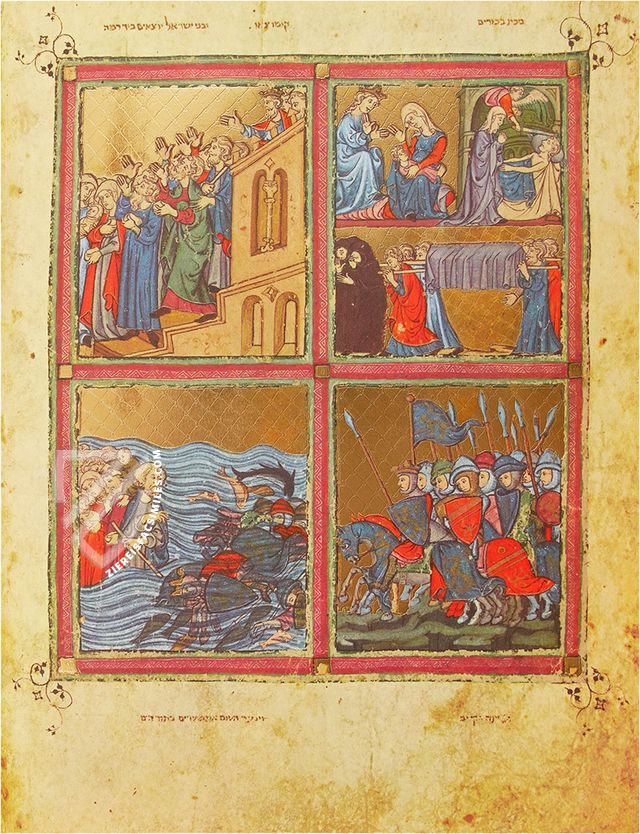
#1 The Golden Haggadah
Language: English
(3,000€ - 7,000€)
- Treatises / Secular Books
- Apocalypses / Beatus
- Astronomy / Astrology
- Bestiaries
- Bibles / Gospels
- Chronicles / History / Law
- Geography / Maps
- Saints' Lives
- Islam / Oriental
- Judaism / Hebrew
- Single Leaf Collections
- Leonardo da Vinci
- Literature / Poetry
- Liturgical Manuscripts
- Medicine / Botany / Alchemy
- Music
- Mythology / Prophecies
- Psalters
- Other Religious Books
- Games / Hunting
- Private Devotion Books
- Other Genres
- Afghanistan
- Armenia
- Austria
- Belgium
- Colombia
- Croatia
- Cyprus
- Czech Republic
- Denmark
- Egypt
- Ethiopia
- France
- Germany
- Greece
- Hungary
- India
- Iran
- Iraq
- Israel
- Italy
- Japan
- Lebanon
- Luxembourg
- Mexico
- Morocco
- Netherlands
- Palestine
- Peru
- Poland
- Portugal
- Russia
- Serbia
- Spain
- Sri Lanka
- Sweden
- Switzerland
- Syria
- Turkey
- Ukraine
- United Kingdom
- United States
- Uzbekistan
- Aboca Museum
- Ajuntament de Valencia
- Akademie Verlag
- Akademische Druck- u. Verlagsanstalt (ADEVA)
- Aldo Ausilio Editore - Bottega d’Erasmo
- Alecto Historical Editions
- Alkuin Verlag
- Almqvist & Wiksell
- Amilcare Pizzi
- Andreas & Andreas Verlagsbuchhandlung
- Archa 90
- Archiv Verlag
- Archivi Edizioni
- Arnold Verlag
- ARS
- Ars Magna
- ArtCodex
- AyN Ediciones
- Azimuth Editions
- Badenia Verlag
- Bärenreiter-Verlag
- Belser Verlag
- Belser Verlag / WK Wertkontor
- Benziger Verlag
- Bernardinum Wydawnictwo
- BiblioGemma
- Biblioteca Apostolica Vaticana (Vaticanstadt, Vaticanstadt)
- Bibliotheca Palatina Faksimile Verlag
- Bibliotheca Rara
- Boydell & Brewer
- Bramante Edizioni
- Bredius Genootschap
- Brepols Publishers
- British Library
- C. Weckesser
- Caixa Catalunya
- Canesi
- CAPSA, Ars Scriptoria
- Caratzas Brothers, Publishers
- Carus Verlag
- Casamassima Libri
- Chavane Verlag
- Christian Brandstätter Verlag
- Circulo Cientifico
- Club Bibliófilo Versol
- Club du Livre
- CM Editores
- Collegium Graphicum
- Collezione Apocrifa Da Vinci
- Comissão Nacional para as Comemorações dos Descobrimentos Portugueses
- Coron Verlag
- Corvina
- CTHS
- D. S. Brewer
- Damon
- De Agostini/UTET
- De Nederlandsche Boekhandel
- De Schutter
- Deuschle & Stemmle
- Deutscher Verlag für Kunstwissenschaft
- DIAMM
- Droz
- E. Schreiber Graphische Kunstanstalten
- Ediciones Boreal
- Ediciones Grial
- Ediclube
- Edições Inapa
- Edilan
- Editalia
- Edition Deuschle
- Edition Georg Popp
- Edition Leipzig
- Edition Libri Illustri
- Editiones Reales Sitios S. L.
- Éditions de l'Oiseau Lyre
- Editions Medicina Rara
- Editorial Casariego
- Editorial Mintzoa
- Editrice Antenore
- Editrice Velar
- Edizioni Edison
- Egeria, S.L.
- Eikon Editores
- Electa
- Emery Walker Limited
- Enciclopèdia Catalana
- Eos-Verlag
- Ephesus Publishing
- Ernst Battenberg
- Eugrammia Press
- Extraordinary Editions
- Fackelverlag
- Facsimila Art & Edition
- Facsimile Editions Ltd.
- Facsimilia Art & Edition Ebert KG
- Faksimile Verlag
- Feuermann Verlag
- Folger Shakespeare Library
- Franco Cosimo Panini Editore
- Friedrich Wittig Verlag
- Fundación Hullera Vasco-Leonesa
- G. Braziller
- Gabriele Mazzotta Editore
- Gebr. Mann Verlag
- Gesellschaft für graphische Industrie
- Getty Research Institute
- Giovanni Domenico de Rossi
- Giunti Editore
- Graffiti
- Grafica European Center of Fine Arts
- Guido Pressler
- Guillermo Blazquez
- Gustav Kiepenheuer
- H. N. Abrams
- Harrassowitz
- Helikon
- Hendrickson Publishers
- Henning Oppermann
- Herder Verlag
- Hes & De Graaf Publishers
- Hoepli
- Holbein-Verlag
- Hortus Deliciarum
- Houghton Library
- Hugo Schmidt Verlag
- Idion Verlag
- Il Bulino, edizioni d'arte
- ILte
- Imago
- Insel Verlag
- Instituto Nacional de Antropología e Historia
- Istituto dell'Enciclopedia Italiana - Treccani
- Istituto Ellenico di Studi Bizantini e Postbizantini
- Istituto Geografico De Agostini
- Istituto Poligrafico e Zecca dello Stato
- Italarte Art Establishments
- J. Thorbecke
- Jan Thorbecke Verlag
- Johnson Reprint Corporation
- Josef Stocker
- Josef Stocker-Schmid
- Jugoslavija
- Karl W. Hiersemann
- Kasper Straube
- Kaydeda Ediciones
- Kindler Verlag / Coron Verlag
- Kodansha International Ltd.
- Konrad Kölbl Verlag
- Kurt Wolff Verlag
- La Liberia dello Stato
- La Linea Editrice
- La Meta Editore
- Lambert Schneider
- Landeskreditbank Baden-Württemberg
- Leo S. Olschki
- Les Incunables
- Library of Congress
- Libreria Musicale Italiana
- Lichtdruck
- Lito Immagine Editore
- Lumen Artis
- Lund Humphries
- M. Moleiro Editor
- Maison des Sciences de l'homme et de la société de Poitiers
- Manuscriptum
- Martinus Nijhoff
- Maruzen-Yushodo Co. Ltd.
- MASA
- McGraw-Hill
- Militos
- Millennium Liber
- Müller & Schindler
- Nahar and Steimatzky
- National Library of Wales
- Neri Pozza
- Nova Charta
- Oceanum Verlag
- Odeon
- Orbis Mediaevalis
- Orbis Pictus
- Österreichische Staatsdruckerei
- Oxford University Press
- Pageant Books
- Parzellers Buchverlag
- Patrimonio Ediciones
- Pattloch Verlag
- PIAF
- Pieper Verlag
- Plon-Nourrit et cie
- Prestel Verlag
- Princeton University Press
- Prisma Verlag
- Priuli & Verlucca, editori
- Pro Sport Verlag
- Propyläen Verlag
- Pytheas Books
- Quaternio Verlag Luzern
- Reales Sitios
- Recht-Verlag
- Reichert Verlag
- Reichsdruckerei
- Riehn & Reusch
- Roberto Vattori Editore
- Rosenkilde and Bagger
- Roxburghe Club
- Salerno Editrice
- Sarajevo Svjetlost
- Schöck ArtPrint Kft.
- Scolar Press
- Scrinium
- Scripta Maneant
- Scriptorium
- Siloé, arte y bibliofilia
- SISMEL - Edizioni del Galluzzo
- Sociedad Mexicana de Antropología
- Société des Bibliophiles & Iconophiles de Belgique
- Soncin Publishing
- Sorli Ediciones
- Stainer and Bell
- Studer
- Styria Verlag
- Sumptibus Pragopress
- Szegedi Tudomànyegyetem
- Taberna Libraria
- Tarshish Books
- Taschen
- Tempus Libri
- Testimonio Compañía Editorial
- Thames and Hudson
- The Clear Vue Publishing Partnership Limited
- The Facsimile Codex
- The Folio Society
- The Marquess of Normanby
- The Richard III and Yorkist History Trust
- Tip.Le.Co
- TouchArt
- TREC Publishing House
- TRI Publishing Co.
- Trident Editore
- Typis Regiae Officinae Polygraphicae
- Union Verlag Berlin
- Universidad de Granada
- University of California Press
- University of Chicago Press
- Urs Graf
- Vallecchi
- Van Wijnen
- VCH, Acta Humaniora
- VDI Verlag
- VEB Deutscher Verlag für Musik
- Verlag Anton Pustet / Andreas Verlag
- Verlag Bibliophile Drucke Josef Stocker
- Verlag der Münchner Drucke
- Verlag für Regionalgeschichte
- Verlag Styria
- Vicent Garcia Editores
- W. Turnowsky
- Waanders Printers
- Wiener Mechitharisten-Congregation (Wien, Österreich)
- Wissenschaftliche Buchgesellschaft
- Wydawnictwo Dolnoslaskie
- Xuntanza Editorial
- Zakład Narodowy
- Zollikofer AG

